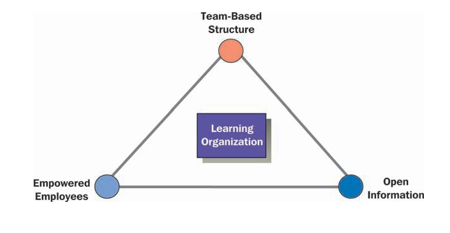One of the toughest challenges for managers today is to direct people’s focus on adaptive change to meet the demands of a turbulent and rapidly changing environment. Few prob- lems come with ready-made solutions, and they require that people throughout the com- pany think in new ways and learn new values and attitudes.52 These needs demand a new approach to management and a new kind of organization.
Managers began thinking about the concept of the learning organization after the pub- lication of Peter Senge’s book, The Fifth Discipline: The Art and Practice of Learning Orga- nizations.53 Senge described the kind of changes that managers have to undergo to help their organizations adapt to an increasingly chaotic world. These ideas gradually evolved to describe characteristics of the organization itself. No single view describes what the learn- ing organization looks like. The learning organization is an attitude or philosophy about what an organization can become.
1. DEFINITION OF A LEARNING ORGANIZATION
The learning organization can be defined as one in which everyone is engaged in identify- ing and solving problems, enabling the organization to continuously experiment, change, and improve, thus increasing its capacity to grow, learn, and achieve its purpose. The es- sential idea is problem solving, in contrast to the traditional organization designed for effi- ciency. In the learningorganization, all employees look for problems, such as understand- ing special customer needs. Employees also solve problems, which means putting things together in unique ways to meet a customer’s needs.
Many of today’s managers are quite aware that sustained competitive advantage can come only by developing the learning capacity of everyone in the organization. This aware- ness is reflected in a survey conducted by Strategy Business. The magazine asked its online subscribers, along with a group of thinkers, educators, interview subjects, and scholars, to vote for the ideas discussed in Strategy Business over the last 10 years that they consider most likely to remain relevant for at least the next decade. The concept of the learning or- ganization ranked second on the list of top 10 ideas.54
2. CHARACTERISTICS OF A LEARNING ORGANIZATION
To develop a learning organization, managers make changes in all the subsystems of the organization. Three important adjustments to promote continuous learning are: shifting to a team-based structure, empowering employees, and sharing information. These three characteristics are illustrated in Exhibit 1.6, and each is described here.
Team-based structure. An important value in a learning organization is collab- oration and communication across departmental and hierarchical boundaries. Self-directed teams comprise the basic building block of the structure. These teams are made up of employees with different skills who share or rotate jobs to produce an entire product or service. Traditional management tasks are pushed down to lower levels of the organization, with teams often taking responsibility for training, safety, scheduling, and deci- sions about work methods, pay and reward systems, and coordination with other teams.
Although team leadership is vital, in learning organizations the traditional boss is nearly eliminated. People on the team are given the skills, information, tools, motivation, and authority to make decisions central to the team’s performance and to respond creatively and flexibly to new challenges and opportunities that arise.
Employee empowerment. Empowerment means unleashing the power and creativity of employees by giving them the freedom, resources, information, and skills to make decisions and perform effectively. Traditional management tries to limit employees, whereas empowerment expands their behavior. Empowerment may be reflected in self- directed work teams, quality circles, job enrichment, and employee-participation groups, as well as through decision-making authority, training, and information so people can per- form jobs without close supervision.

In learning organizations, people are a manager’s primary source of strength, not a cost to be minimized. Companies that adopt this perspective believe in treating employees well by providing competitive wages and good working conditions, as well as by investing time and money in training programs and opportunities for personal and professional develop- ment. In addition, they often provide a sense of employee ownership by sharing gains in productivity and profits.55
Open Information. A learning organization is flooded with information. To identify needs and solve problems, people have to be aware of what’s going on. They must understand the whole organization as well as their part in it. Formal data about budgets, profits, and departmental expenses are available to everyone. “If you really want to respect individuals,” says Solectron Corp.’s Winston Chen, “you’ve got to let them know how they’re doing—and let them know soon enough so they can do something about it.”56
Managers know that providing too much information is better than providing too little. In addition, managers encourage people throughout the organization to share information. For example, at Viant Inc., which helps companies build and maintain web-based busi- nesses, people are rewarded for their willingness to absorb and share knowledge. Rather than encouraging consultants to hoard specialized knowledge, CEO Bob Gett says, “We value you more for how much information you’ve given to the guy next to you.”
Source: Daft Richard L., Marcic Dorothy (2009), Understanding Management, South-Western College Pub; 8th edition.

Hello, you used to write great, but the last few posts have been kinda boringK I miss your tremendous writings. Past few posts are just a little bit out of track! come on!